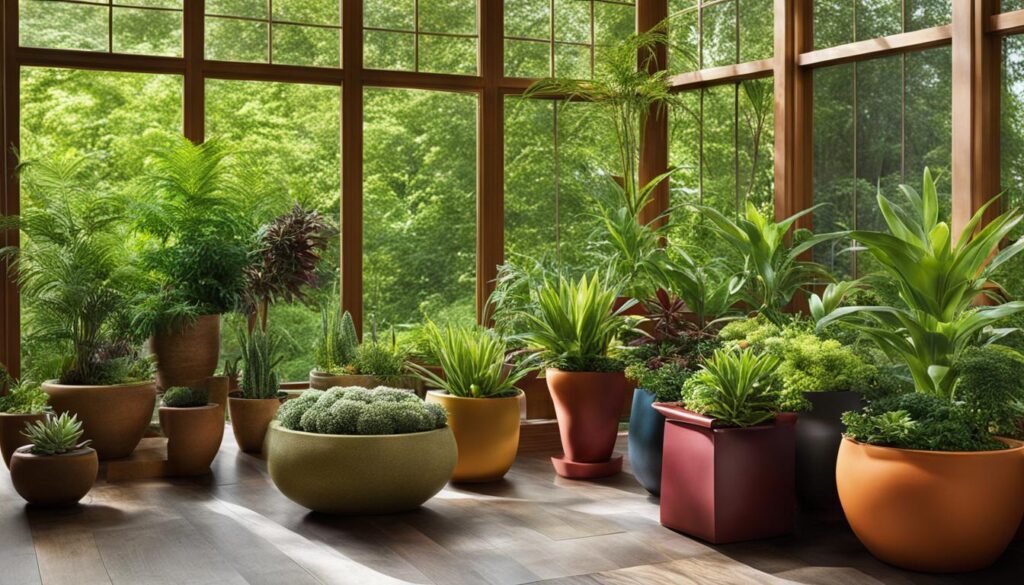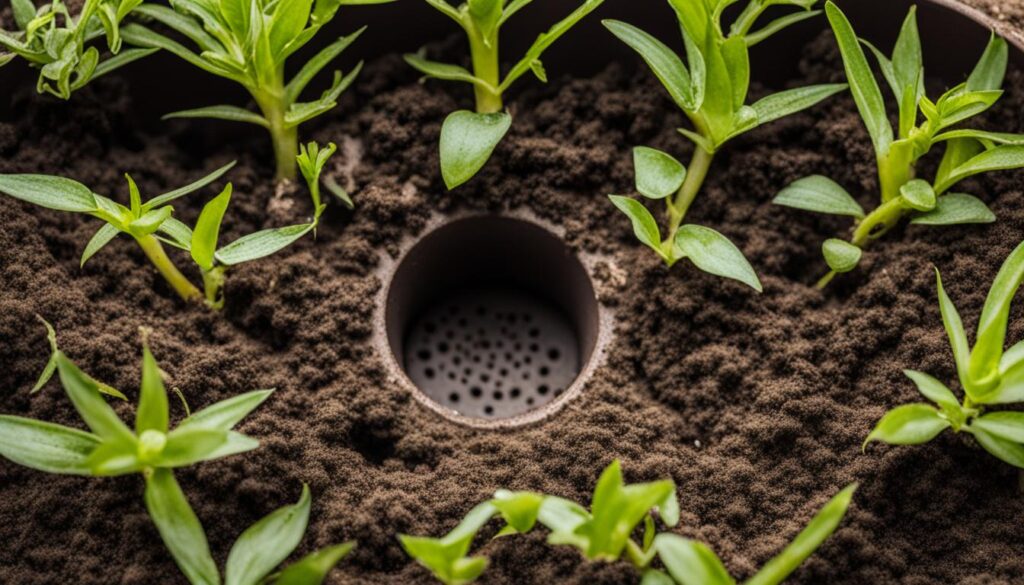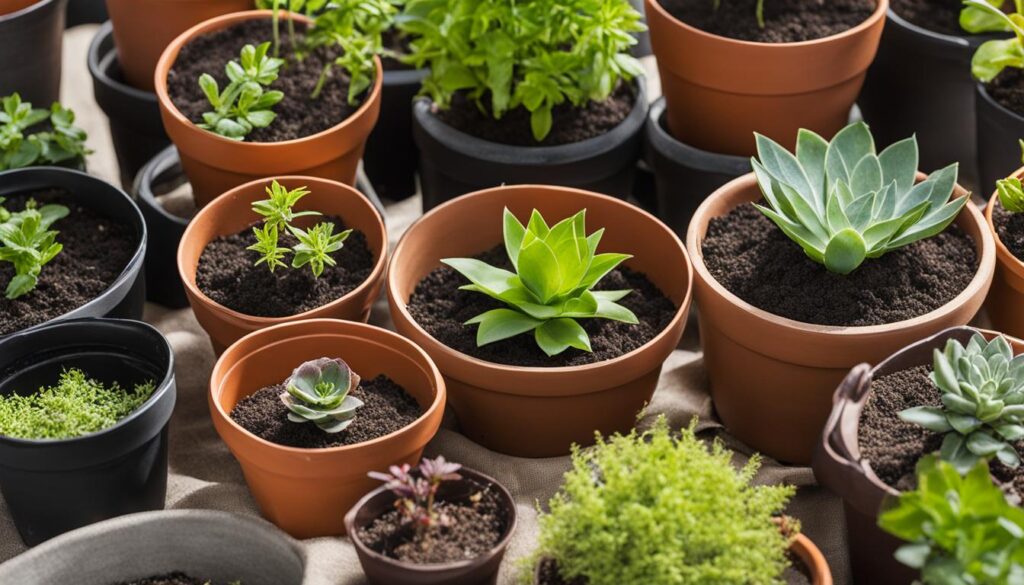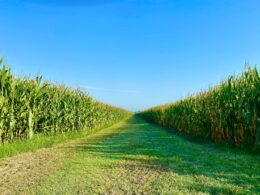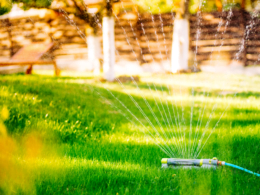When it comes to potting plants, choosing the right size of pot or planter is crucial for their growth and overall health. The size of the container directly affects the root growth, nutrient absorption, and water drainage. It’s essential to understand the relationship between plant size and pot size to ensure optimum conditions for your plants. Here is a comprehensive guide to potting soil sizes to help you make the right choice.
- Choosing the right pot or planter size is crucial for the growth and health of your plants.
- The size of the container determines root growth, nutrient absorption, and water drainage.
- Understanding pot and planter terminology is important when discussing potting soil sizes.
- Repotting your plants provides fresh potting mix, allowing them to grow and thrive.
- Proper drainage in planters is essential to prevent root rot and excess water accumulation.
Understanding Pot and Planter Terminology
The terms “pot” and “planter” are often used interchangeably, but there is a slight distinction. Pots are generally smaller, round containers designed for individual plants, while planters are meant for outdoor use, irregular in size, and can accommodate multiple plants. However, in the context of this guide, both terms are used to refer to indoor plant containers. It’s important to be familiar with this terminology when discussing potting soil sizes.
When it comes to choosing the right pot or planter for your indoor plants, there are a few things to consider. Pots are typically made of materials like clay, ceramic, or plastic and are available in various sizes. On the other hand, planters are larger and can be made of materials like wood, metal, or fiberglass.
Choosing between a pot and a planter depends on factors like the size of your plant, the space available, and the aesthetic you’re going for. Pots are ideal for smaller plants or when you want to showcase individual specimens. Planters, with their larger size and multiple plant capacity, are perfect for creating beautiful arrangements or housing larger plants.
“Understanding the distinction between pots and planters is crucial when selecting the right containers for your indoor plants.”
So, whether you prefer the versatility of a pot or the statement-making potential of a planter, understanding the terminology will help you make an informed decision when it comes to choosing the right size for your indoor plant containers.
Table: Comparing Pots and Planters
| Pots | Planters |
|---|---|
| Smaller, round containers | Larger, irregular-shaped containers |
| Designed for individual plants | Can accommodate multiple plants |
| Made of materials like clay, ceramic, or plastic | Can be made of materials like wood, metal, or fiberglass |
| Available in various sizes | Offer more space for larger plants |
Importance of Repotting and Pot Size
Repotting your plants is a crucial step in their care routine. Not only does it provide them with fresh potting mix, but it also allows them to sustain their current size or even grow larger. As plants mature, their root systems expand, requiring more space to spread out and absorb nutrients effectively. This is where repotting and choosing the right pot size come into play.
When you first bring a plant home, repotting may not involve going up a pot size. Instead, it may be necessary to replace the degraded potting mix to ensure the plant receives the necessary nutrients. However, as the plant outgrows its current pot, a larger pot becomes essential. The size of the pot should be carefully considered, as it directly impacts the plant’s overall health and growth.
For pots that are 10 inches or smaller in diameter, the new pot should be approximately 1-2 inches larger than the current one. This additional space allows the roots to continue growing and expanding. In the case of pots larger than 10 inches in diameter, it’s best to opt for a pot that is 2-3 inches larger than the current one. This extra room provides ample space for the roots to thrive and develop, ultimately promoting healthier plant growth.
By repotting your plants and selecting the appropriate pot size, you’re ensuring that they have the space and resources they need to flourish. It’s a simple yet effective way to support their overall health and longevity.
Table: Recommended Pot Sizes Based on Plant Size
| Plant Size | Current Pot Size | Recommended Pot Size |
|---|---|---|
| Small (6-12 inches) | 4-6 inches | 6-8 inches |
| Medium (12-24 inches) | 6-8 inches | 8-10 inches |
| Large (24+ inches) | 8-10 inches | 10-12 inches |
Remember, it’s important to monitor your plants’ growth and repot them accordingly. By providing them with the right pot size, you’re setting them up for success and ensuring they have the room they need to thrive.
The Significance of Drainage in Planters
Proper drainage in planters is essential for the overall health and well-being of your plants. When excess water cannot escape from the container, it can lead to waterlogging and root rot, which can be detrimental to the plants’ survival. Therefore, it’s important to understand the significance of drainage and how to improve it in your planters.
The presence of drainage holes in planters is ideal as it allows excess water to escape, preventing it from getting trapped around the roots. If your planter does not have pre-drilled holes, you can create them by using a drill or hammer and nail. Additionally, adding a layer of coarse materials such as lava rocks or broken pottery at the bottom of the planter can further improve drainage. These materials provide crevices for excess water to accumulate and drain into, reducing the risk of waterlogging.
When watering your plants, it’s important to avoid overwatering, as this can lead to water accumulation in the planter. Always check the moisture level of the soil before watering, and adjust the frequency of watering based on the specific needs of your plants.
Common signs of poor drainage in planters include:
- Water pooling on the surface of the soil after watering
- Yellowing or wilting of the plant’s leaves
- Foul odor coming from the planter
- Mold or fungus growth on the soil surface
“Proper drainage in planters is crucial for the overall health of your plants. Waterlogged soil can lead to root rot and other issues that can weaken or even kill your plants.”
By ensuring adequate drainage in your planters, you create an environment that promotes healthy root growth and prevents water-related problems. Regularly inspect the drainage holes and clear out any blockages to maintain the functionality of the drainage system. With proper drainage, you can provide your plants with the optimal conditions they need to thrive.
| Signs of Poor Drainage | Solutions |
|---|---|
| Water pooling on the soil surface after watering | Check for and clear any blockages in the drainage holes |
| Yellowing or wilting leaves | Adjust watering frequency and reduce the amount of water given |
| Foul odor | Ensure proper airflow and consider repotting in fresh soil |
| Mold or fungus growth | Allow the soil to dry out between waterings and improve airflow |
Choosing the Right Pot Size: Secrets Revealed
When it comes to potting plants, selecting the right pot size is crucial for their overall health and growth. Understanding the relationship between pot size and the roots of your plants is essential for creating the optimal environment. By following a few simple guidelines, you can ensure that your plants have enough space to thrive and flourish.
To determine if your current pot size is suitable for your plant, it’s helpful to examine the roots. If the roots are filling the container or growing out of the drainage holes, it’s a clear sign that your plant needs a larger pot. On the other hand, if there is excess soil compared to the roots, it may be time to consider a smaller pot. To strike the right balance, aim for a pot that is approximately two inches larger in diameter than the plant’s current size.
When it comes to repotting, it’s important to avoid jumping to a much larger pot size all at once. Gradual repotting is the preferred method as it allows the plant to adjust to its new container and reduces the risk of water retention and potential root rot. By gradually increasing the pot size over time, you provide the roots with enough room to grow without overwhelming them.
Pot Size Guidelines:
- Examine the roots: If they are filling the current pot or growing out of the drainage holes, consider a larger pot.
- Excess soil to roots ratio: If there is more soil than roots, opt for a smaller pot.
- Choose a pot approximately two inches larger in diameter than the plant’s current size.
- Opt for gradual repotting to allow the roots to adjust and prevent water retention.
By taking these factors into consideration and selecting the appropriate pot size, you can provide your plants with the ideal conditions for healthy root development and overall plant growth. Remember to observe the roots, choose the right diameter, and opt for gradual repotting when necessary. Your plants will thank you with lush foliage and vibrant blooms.
Pot Shape Considerations for Different Plants
When choosing a pot for your plants, it’s not just about the size, but also the shape that matters. Different plants have varying root systems, and the right pot shape can provide them with the ideal environment for growth. Here are some pot shape considerations to keep in mind:
Pot shape and container volume
The shape of the pot can influence the volume of the container. For shallow-rooted plants like succulents and cacti, wide and shallow pots are recommended. These pots provide ample space for the roots to spread horizontally while ensuring proper drainage. On the other hand, plants with deeper root systems, such as larger herbs or plants with abundant foliage, require taller pots. This allows for deeper root penetration and accommodates the larger volume of soil needed for nutrient absorption.
Soil reservoir and root depth
Choosing the right pot shape can also affect the soil reservoir and root depth. Plants with shallow root systems don’t require a deep soil reservoir and can thrive in pots with limited soil volume. On the contrary, plants with deeper roots benefit from pots that provide enough soil depth for the roots to establish and grow. A well-structured pot with sufficient soil depth ensures the plants have access to necessary nutrients and water.
Visual appeal and aesthetics
Pot shape can also play a role in enhancing the visual appeal of your plants. Opting for pots that complement the plant’s growth habit and foliage can create a visually pleasing arrangement. Tall pots can add height and drama to your plant display, while rounded pots can soften the look with a more organic feel. Consider the overall aesthetics of your indoor space and select pot shapes that harmonize with the style and atmosphere you want to create.
| Pot Shape | Best Suited Plants |
|---|---|
| Wide and shallow | Succulents, cacti |
| Tall and narrow | Herbs, plants with abundant foliage |
| Rounded | Flowering plants, ferns |
| Square or rectangular | Herbs, vegetables |
Remember, choosing the right pot shape is as important as selecting the right pot size. By considering the needs of your plants’ root systems, soil reservoir requirements, and visual appeal, you can create a harmonious environment that promotes healthy growth and adds beauty to your indoor space.
How Can I Use Home-Built Garden Soil for Potting Plants?
If you’re interested in building garden soil at home, consider using a mix of compost, topsoil, and organic matter for potting plants. Combine these ingredients in the right proportions to create a nutrient-rich soil that will help your plants thrive. With a little effort, you can create the perfect growing medium for your garden.
Conclusion
Choosing the right potting soil size is vital for the health and thriving of your plants. By understanding the terminology, the significance of repotting, drainage, and pot size considerations, you can make informed decisions that will benefit your plants’ well-being.
Observing the roots is a key indicator of whether you need to choose a larger or smaller pot size for your plant. If the roots are filling the current container or growing out of the drainage holes, it’s time for a larger pot. Conversely, if there is excess soil compared to the roots, a smaller pot is needed.
When selecting a pot, aim for a size that is slightly larger than the current one. For pots of 10 inches or smaller, a pot that is 1-2 inches larger in diameter is suitable. For larger pots, go for a size that is 2-3 inches larger. This gradual repotting approach helps prevent water retention and potential root rot.
Additionally, consider the shape of the pot, as different plants require different pot shapes to accommodate their root systems. Shallow, wide pots are ideal for succulents and cacti with shallow root systems, while larger herbs and plants with abundant foliage thrive in taller pots that provide ample space for root growth and nutrient absorption.
By following these guidelines, you can create optimal conditions for your plants, ensuring they stay healthy and flourish in their environment.
FAQ
What is the difference between a pot and a planter?
Pots are generally smaller, round containers designed for individual plants, while planters are meant for outdoor use, irregular in size, and can accommodate multiple plants. However, in the context of this guide, both terms are used to refer to indoor plant containers.
Why is repotting important, and when should I use a larger pot?
Repotting provides plants with fresh potting mix and allows them to sustain their current size or grow larger. A larger pot is needed when the plant outgrows its current pot. The size of the pot should be 1-2 inches larger for pots of 10 inches or smaller, and 2-3 inches larger for pots larger than 10 inches in diameter.
How important is drainage in planters?
Drainage is crucial for the overall health of your plants, especially if you’re still honing your watering skills. While it’s best to choose planters and pots with proper drainage holes, you can improve drainage by adding a layer of lava rocks or similar material at the bottom of the planter.
How do I choose the right pot size?
To determine if the current pot is the right size, examine the roots. If the roots fill the container or start growing out of the drainage holes, a larger pot is needed. Generally, pots that are approximately two inches larger in diameter than the plant’s diameter are suitable. Gradual repotting is recommended to prevent water retention and potential root rot.
Do pot shapes matter for plant growth?
Yes, different plants require different pot shapes to accommodate their root systems. Succulents and cacti thrive in shallow, wide pots, while larger herbs, shrubs, and plants with abundant foliage need taller pots. Consider both the size and shape of the pots to ensure adequate space for root growth and nutrient absorption.






